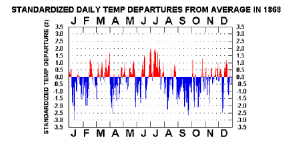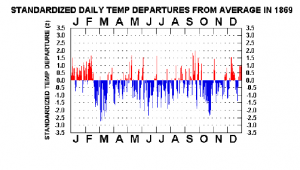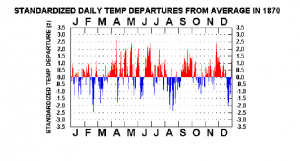Over the next few weeks, I’ll be digging into some of the information I brought back from Sweden.
First up is Colonel Hans Mattson. To review: my great-great-grandfather, John Martinson, came to America in 1869. He was from Skoglösa farm in Önnestad parish. One of his traveling companions wrote a diary (“The Aspengren Diary”) about their trip. The diary mentions the group’s leader, Col. Hans Mattson. He is described as a land agent and seems to be in charge of all of the travel arrangements. He takes the group to Minnesota. Upon arrival, John Martinson and his traveling companions decide that Minnesota is too cold and they move on to Nebraska. Col. Mattson is disappointed in their decision but cannot compel them to stay.
In reading the Aspengren Diary, I had always regarded Col. Matson as some sort of side character, perhaps unscrupulous, and really hadn’t give him much thought. However, I was surprised to see Col. Mattson featured at the Emigrant Museum in Växjö. Here’s the placard that was next to his photo (click on image for magnified view):
 Just a couple of minutes of Googling reveals a treasure trove of information about Col. Mattson. For one thing, he’s got his own wikipedia page that’s definitely worth a read – the first thing that’s mentioned is that he was born in Önnestad parish. What a fascinating life he led. I also found that he wrote an autobiography, which I was able to find online. It’s a free digital download. I downloaded it in pdf format (136 pages) and will be reading through it in the coming weeks.
Just a couple of minutes of Googling reveals a treasure trove of information about Col. Mattson. For one thing, he’s got his own wikipedia page that’s definitely worth a read – the first thing that’s mentioned is that he was born in Önnestad parish. What a fascinating life he led. I also found that he wrote an autobiography, which I was able to find online. It’s a free digital download. I downloaded it in pdf format (136 pages) and will be reading through it in the coming weeks.
Glancing through the autobiograpy, something that I noticed right away is that he was born and raised at Skoglösa – the same farm village where John Martinson lived. I looked up the church records for 1832 and it turns out that Hans Mattson was born at Skoglösa No. 6 – the very same farm where John Martinson and his family lived before they came to America. Crazy stuff!

It gets even crazier. In Chapters I and IX of his autobiography, Mattson describes a spruce tree that his parents planted in front of their cottage in Skoglösa sometime before 1830. When he returns to Skoglösa No. 6 in January 1870, he is delighted to see the tree still standing, “the pride not only of the present owner of the little farm, but of the whole neighborhood.” He cuts off a sprig to take back to his parents, now living in America. However, that very night, a freak gust of wind felled the tree and the owner of the cottage “regarded it as an ill-omen, sold the place shortly afterward, and went with me to America the following spring.”
I wonder – was it John Martinson and his family living in that cottage? Did my ancestors come to America because a tree fell over? There were many families living at Skoglösa No. 6, and many of them came to America with Mattson that spring, so I don’t know for sure that it John Martinson’s tree. Still, it’s a good story! [Update 11/19/2014: Nope, John had already left Skoglösa in 1869. Wife Nilla and the kids were living at Skoglösa No. 6 in January 1870, but I’m sure they had already decided to leave for America by then.]
A “Sweden-America” day is celebrated in Önnestad each August, and they award a “Hans Mattson Plaque” every year. Here’s an article from the 2010 celebration, and in 2012 they honored composer Leroy Anderson. Gosh, I’d love to attend this event someday.
Bonus Engineering Content: Finally, as a water resources engineer, I have to ask myself: was it really that cold in Minnesota? Arriving in the early summer of 1869, the group would have been hearing from the locals about the winter of 1868-1869. What were the temperatures like during those two years?
 It looks like June and July of 1868 were really hot, but then a cold spell started in August and it persisted into the fall and early winter.
It looks like June and July of 1868 were really hot, but then a cold spell started in August and it persisted into the fall and early winter.
 In 1869, January was very warm and mild, but then it was back to cold again, and the cold persisted throughout most of the year. It was on June 7 that John Martinson and his companions decided that Minnesota was too cold (and it was!).
In 1869, January was very warm and mild, but then it was back to cold again, and the cold persisted throughout most of the year. It was on June 7 that John Martinson and his companions decided that Minnesota was too cold (and it was!).
Had they arrived a year later, however, they might have rejected Minnesota for entirely different reasons. There were torrential flooding rains in August and September of 1869, followed by a really hot spring and summer in 1870.
(Climate data from http://www.climatestations.com/minneapolis/)


Thanks for all the info. I bet seeing all those places where our ancestors trod put a chill down your spine. I think there were some Mattson’s that lived around Ceresco. Not sure if they were related to the Colonel though. Might be somewhat of a common name among us swedes.? Thanks again Karen.
Doug